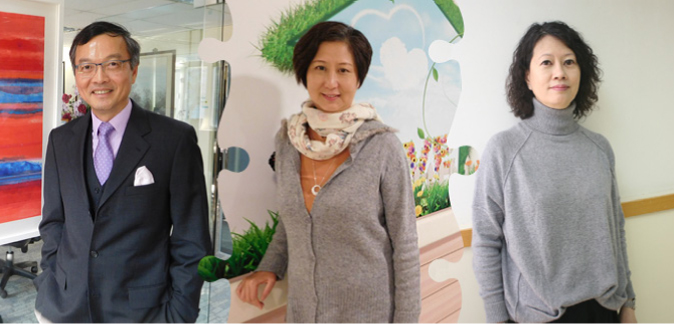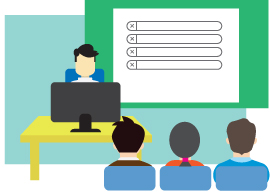 |
|
The adoption of the Electronic Health Record Sharing System (eHRSS) can offer a lot of benefits to elderly care institutions in providing long-term care for their elderly residents and patients. Three non-governmental organisations (NGOs) shared their experience. |
|
|
| |
 |
| |
The concept of eHR sharing is not new to HOHCS. For years, the organisation has been using an internal system to share patients’ records among different service units. eHRSS nonetheless introduces a new dimension in the care it provides.
“Joining eHRSS enables HOHCS to access elderly patients’ records kept at public hospitals and private clinics. Such sharing is conducive to the seamless delivery of healthcare by different healthcare providers (HCPs) and healthcare professionals,” said Dr Lam Ching-choi, Chief Executive Officer of HOHCS. |
|
|
| |
| Dr Lam, who also chairs the Elderly Commission and the Community Investment and Inclusion Fund Committee, said elderly care service used to be seen as a “high (personal) touch low technology” field. However, there has been a positive change in mindset over the past decade with the advancement of information technology, he added. |
| |
Describing eHRSS as user-friendly, Dr Lam said, “A user-friendly system, coupled with sufficient training will help frontline healthcare staff of NGOs embrace new technologies and attract more young people to join the elderly care force.”
He also suggested enhancing on-site demonstration and briefings to ease frontline staff’s anxiety over the new system and help them better utilise it to deliver quality services.
On future developments, Dr Lam said the inclusion of Chinese medicine in Stage 2 of the eHR programme can provide a channel to promote integration of Chinese and Western healthcare in the long run. |
 |
| Enhancing on-site demonstration and briefings can help frontline staff better utilise the new systems to deliver quality services |
|
|
|
| |
| “Some patients may forget or hesitate to let their doctors know that they are concurrently receiving treatment from Chinese medical practitioners. If these medical records can also be obtained from eHRSS, HCPs can get hold of the relevant information more easily,” he added. |
| |
| Dr Lam also supported the idea of setting up a patient portal, as he believes it will promote self-management by patients. The increased accessibility of patients’ health records will also help enhance healthcare services delivered by NGOs, as collaboration between healthcare and social service providers is the emerging trend in elderly care. |
| |
| “This is particularly useful as Hong Kong is facing the challenge of an aging population and we are actively promoting the concept of ‘Ageing in Place’,” he remarked. |
| |
 |
| |
|
PLK has long been a supporter of eHR sharing. Its residential homes and home care services for elderly have joined the Public-Private Interface–Electronic Patient Record Sharing Pilot Project (PPI-ePR) before participating in eHRSS.
Recalling the times before joining the eHR programme, Ms Lai Miu-yin, Senior Residential Elderly Services Manager of PLK, said during those days, healthcare staff members could only rely on the limited information provided by the elderly to assess their health conditions.
|
|
|
| |
| “With PPI-ePR, our staff can obtain useful health information of the elderly, such as discharge summaries kept by hospitals. We did not hesitate much in joining eHRSS, knowing that more information such as patients’ blood pressure records, blood glucose levels and medical appointments from different public and private HCPs is also available on the platform,” she said. |
| |
| “This can help us provide more comprehensive healthcare and better advice to patients while at the same time improving communication between NGO healthcare staff and other HCPs,” said Ms Lai, who is also a registered Chinese medicine practitioner and a registered nurse. |
| |
| Recently PLK has participated in the Hospital Authority’s Public-Private Partnership Programme in the provision of infirmary service. Under this programme, service users admitted to PLK’s Wong Chuk Hang Extended Care Home are required to register with eHRSS. |
| |
| “Healthcare staff of the centre can access patients’ records as soon as they are discharged from hospitals. The information in eHRSS can also be made available to visiting medical officers for reference before they come to the centre,” Ms Lai explained. |
| |
| While agreeing that the system design of eHRSS is user-friendly, Ms Lai said more hands-on training, or promotional videos put on the internet, can help healthcare staff better understand how to use the system. |
| |
| “In the coming year, we are planning to extend our eHRSS participation to 13 centres covered by our Community Support Services, such as neighbourhood elderly centres. Training and support will definitely facilitate our staff to be better prepared for the new mode of work.” |
| |
| Currently Chinese medical service is also provided by PLK. So when asked about how eHRSS can further improve, Ms Lai said it will no doubt benefit both patients and healthcare staff if patients’ Chinese medical treatment records are also captured. |
| |
 |
| |
The Caritas HL Home is among the first batch of NGO healthcare service providers who have joined eHRSS. All of its elderly residents have also registered with eHRSS, either by themselves or with the help of their substitute decision makers.
With almost half of the elderly residents being dementia patients, the concept of eHRSS can help meet the needs in providing care for the elderly residents, according to Ms Doris Yu, Superintendent of the Caritas HL Home. |
|
|
| |
| “Our staff members cannot and should not rely on the elderly as the source of their own medical records. They are not able to tell their medical histories, the kinds of surgeries performed on them, and the medications they are taking,” Ms Yu said. |
| |
| Over the past years, the Caritas HL Home has been using an internal system to keep medical related information of elderly residents and communicate the information internally. “For health records kept by other institutions, e.g. discharge summaries and medical reports issued by hospitals, we used to obtain them in the conventional way, like calling the hospitals or making written requests,” said Ms Yu. |
| |
| “Now with eHRSS, our nurses can view the medical records of elderly residents in an easy and convenient way. The system is a ‘one-stop shop’ for patients’ medical records,” she said. |
| |
| Ms Yu said the Caritas HL Home has high family participation in the care of the elderly. “Residents’ families expected us to join the system and were keen to have the elderly registered. They said they can now have their mind at ease,” she said. |
| |
| Turning to expectations on eHRSS, Ms Yu opined that if patients can view their own records in eHRSS in future, simpler and user-friendly medical terms and glossaries should be provided for their easy understanding. |
| |
| As to eHR access by healthcare professionals (HCProfs), so far access has been enabled for medical practitioners, nurses and dentists, in accordance with the Government’s plan to open access to 13 HCProf groups in stages. Ms Yu suggested that opening eHR access to physiotherapists and occupational therapists can help the delivery of comprehensive and integrated care to the elderly residents. |
| |
 |
| |
| More reports on engagement and promotional activities for the elderly are available at eHR Updates. |
| |
|
|

